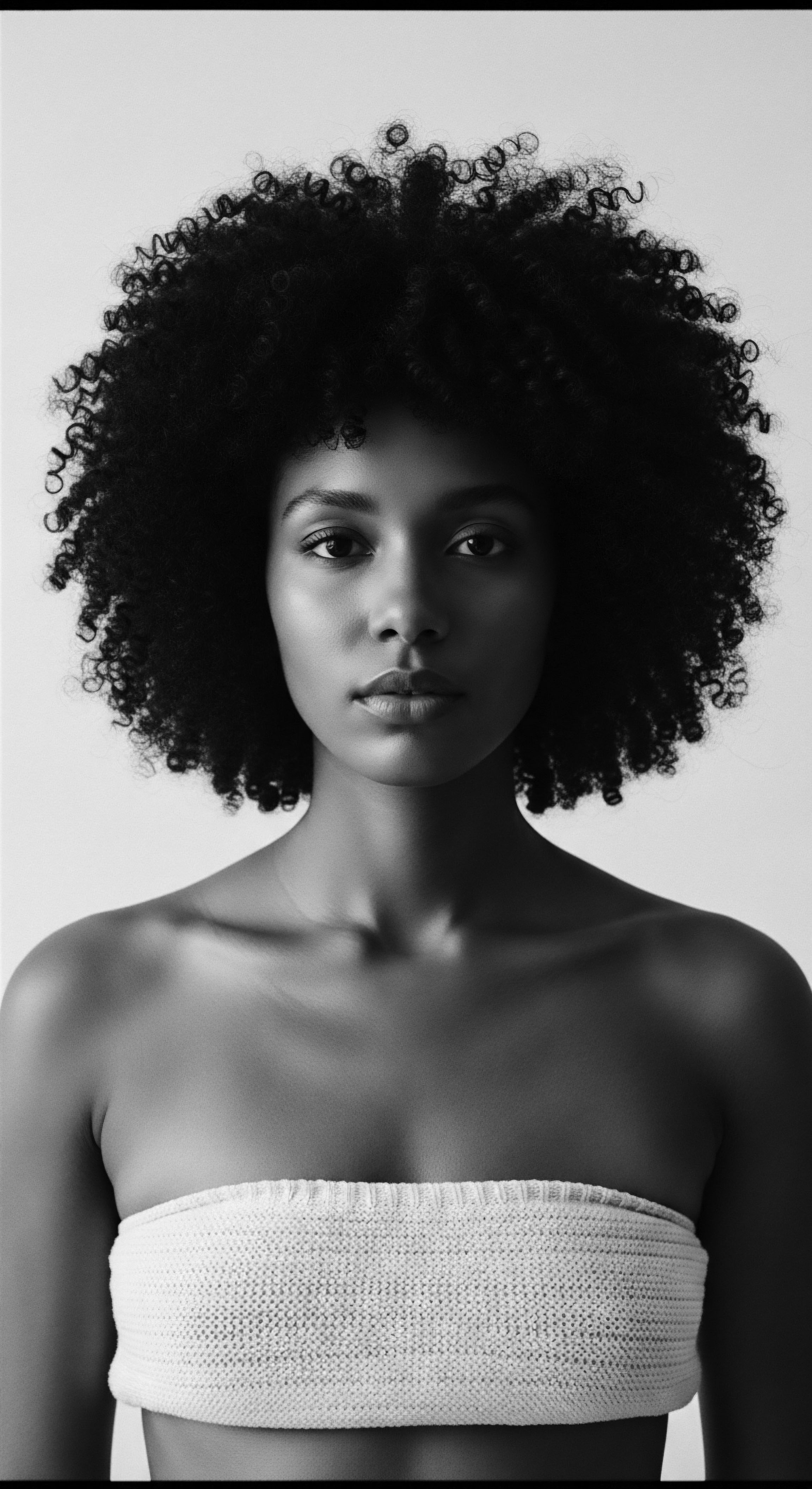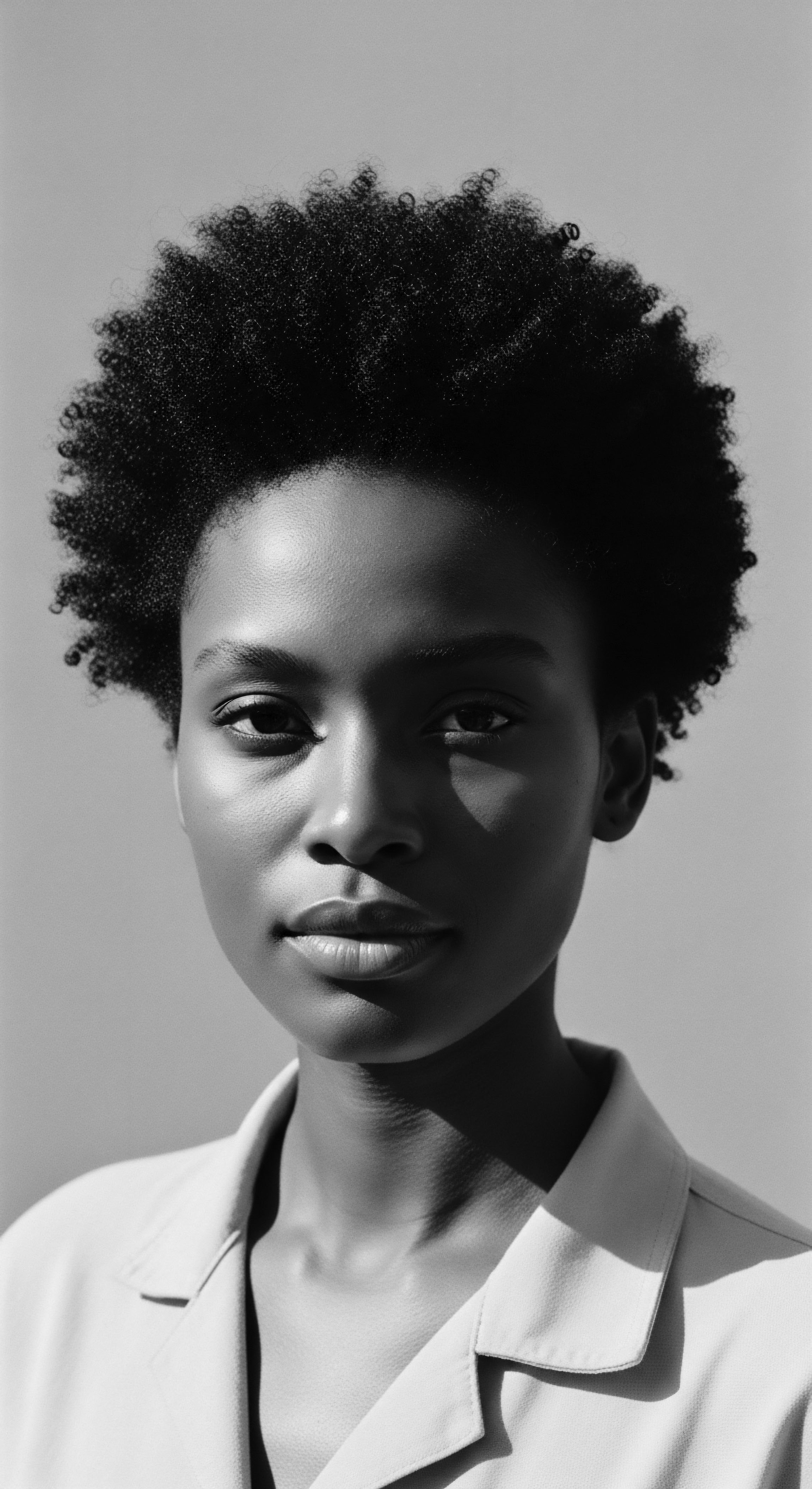
Roots
In the expansive archive of textured hair, each curl and coil whispers tales from ancestral lands, echoing a vibrant heritage. For those of us connected to Black and mixed-race lineages, the journey of our hair is not merely cosmetic; it is a profound living document of cultural resilience, artistic expression, and deep wisdom passed through generations. We seek not just to understand the hues that once adorned these strands but to feel the hands that prepared them, the traditions that informed their application, and the very spirit infused within each coloring ritual. It is a quest to rediscover not just what plants colored Afro-textured hair historically, but why these choices held such immense significance, anchoring identity, status, and connection to the spiritual world.
The earliest records of human hair coloring point to civilizations where hair held immense ceremonial and social value. Ancient Egyptians, for instance, were meticulous in their aesthetic practices, and hair stood at the center of this care. They harnessed the natural pigments of their environment to alter hair’s appearance, often aiming for rich red and brown shades. The practice was widespread, used by both men and women to enhance their looks and maintain social standing.
Beyond personal beautification, hair color in Egyptian society conveyed symbolic meanings, with darker tones often linked to nobility and elevated social positions. This deep connection between hair, color, and societal role was not unique to the Nile Valley; it rippled across the African continent and into the diaspora, forming a continuous thread of cultural meaning.

A Botanical Palette from the Past
When we peer into the historical practices of hair coloring within Afro-textured hair traditions, certain botanical allies consistently appear, forming a palette drawn directly from the earth. These plants, long held as sacred or beneficial, offered a means to shift the natural shade of hair, sometimes for visual appeal, other times for spiritual protection, or even for medicinal purposes.
- Henna (Lawsonia inermis) ❉ This reddish dye, prepared from the dried and powdered leaves of the henna tree, has been used for millennia across North Africa, West Africa, Central Africa, the Horn of Africa, and the Indian subcontinent. Its primary component, lawsone, interacts with hair keratin to produce colors ranging from orange to auburn to burgundy. In regions such as Sudan, henna holds immense symbolic and aesthetic importance, used in wedding rituals and festivals. Sudanese henna, historically, relied on natural variations in leaf preparation to achieve different depths of color, often avoiding synthetic additives. Beyond its color, it was believed to offer medicinal qualities, including fever reduction and treatment for skin ailments.
- Indigo (Indigofera tinctoria) ❉ A striking blue dye, indigo was also historically applied to Afro-textured hair, often in combination with henna to achieve deeper browns and blacks. Cultivated across tropical and temperate regions of Africa, Asia, and the Americas, its leaves yield indigotin, the compound responsible for its vibrant blue hue. West African women, particularly, used indigo not only as a hair dye but also for body painting and to enhance body scarification, seeing it as a sign of power and nobility.
- Walnut Hulls (Juglans regia, Juglans nigra) ❉ The outer green shells of walnuts contain pyrogallol and hydrojuglone, which oxidize to produce strong brown dyes. Pliny the Elder recorded their use as a hair dye as early as the first century AD. For those seeking darker tones, walnut hulls were a reliable source, yielding deep browns and even jet black when combined with other ingredients.
The wisdom embedded in these choices speaks volumes. These weren’t arbitrary selections; they were the result of generational knowledge, careful observation of nature, and an intuitive understanding of chemistry long before modern science articulated the mechanisms. The availability of these plants varied by region, influencing the dominant color palettes and hair traditions of distinct communities.
Traditional plants provided historical color for Afro-textured hair, reflecting cultural values and ancestral knowledge.

Hair Anatomy and the Ancestral View
To truly grasp how these traditional plants interacted with Afro-textured hair, we must consider the unique anatomical structure of these strands. Unlike straight hair, Afro-textured hair often exhibits an elliptical or flat cross-section, with a tighter curl pattern. This structure leads to more cuticle layers and points of stress along the hair shaft. From an ancestral perspective, this unique structure was not a ‘problem’ to be solved but a canvas, a spiritual antenna, and a familial marker.
While modern science details the cortex, medulla, and cuticle, our ancestors understood hair’s capabilities through lived experience. They observed how natural substances adhered, conditioned, and strengthened these particular curls and coils. The application of plant-based dyes was therefore not merely a surface treatment; it was an engagement with the hair’s very being, a way to support its integrity while imparting color.
The lawsone in henna, for instance, binds with the keratin protein, providing a coating that can add body and sheen, almost sheathing the strand. This natural interaction meant that traditional coloring practices were often inextricably linked to general hair health and conditioning, a holistic approach deeply rooted in ancestral wellness philosophies.

Ritual
The coloring of Afro-textured hair in historical contexts was seldom a solitary or purely aesthetic act. It was often interwoven with profound societal rituals, community bonds, and a deep reverence for the plant world. These practices, honed over centuries, transformed raw botanical materials into vibrant expressions of identity, status, and spiritual connection. The meticulous preparation of plant pastes, the careful application, and the communal gatherings surrounding these processes reveal an artistry and a wisdom that speaks to the heart of textured hair heritage.

Preparation and Application Practices
The journey from plant to pigment was a labor of love and knowledge. Consider henna ❉ its leaves, harvested twice a year, underwent a drying process before being meticulously ground into a fine powder. This powder was then mixed with warm water, and sometimes other oils or acidic liquids like lemon juice, to create a paste. The precise consistency and additional ingredients could influence the final shade and how well the dye adhered to the hair.
For darker tones, indigo powder, derived from fermented indigo leaves, would be prepared and often combined with the henna paste. This layering or blending of plant materials allowed for a spectrum of colors, from reddish browns to deep blacks, achieved without harsh chemicals. This careful preparation highlights an understanding of natural chemistry and a patience that reflects the value placed on these hair traditions.
The application itself was often a communal affair, particularly among women. In many African societies, hair care was a significant bonding activity, a time for sharing stories, wisdom, and laughter. The slow, deliberate process of applying these plant pastes to intricate braids or styled coils was a ritual of connection. In Sudan, henna use is deeply embedded in social and cultural heritage, particularly for joyous occasions like weddings.
Both brides and grooms would have their hands and feet, and sometimes hair, tinted with henna, a symbol of auspiciousness and protection. This collective participation underscores how hair coloring transcended individual adornment, becoming a shared experience that reinforced community ties and preserved cultural memory.
Hair coloring in ancestral African practices was often a communal ritual, deepening social bonds and signifying life’s milestones.

Cultural Narratives of Color and Status
The colors imparted by these traditional plants held powerful meanings within pre-colonial African societies. Hair itself was a dynamic canvas for expressing age, marital status, social rank, and tribal affiliation. A particular shade, achieved through specific plant dyes, could instantly communicate a person’s place within their community. For instance, among the Fulani people of West Africa, hairstyles and their adornments, including potential coloring, communicated social status and age.
Married women might wear specific elaborate plaits, suggesting a level of maturity and societal role, while younger, unmarried women might have simpler styles. This visual language, conveyed through hair, was as rich and complex as any spoken tongue.
The use of certain colors could also be linked to spiritual beliefs or protection. Red ochre, though a mineral, was often mixed with plant oils and butterfat to create a reddish coating for hair and skin, notably among the Himba women of Namibia and Hamar women of Ethiopia. While not a direct plant dye in all applications, its combination with plant-derived emollients represents a fusion of natural elements for cosmetic and protective purposes. This practice speaks to a broader ancestral understanding that the body, including hair, was a conduit for spiritual energy and could be adorned or treated to invite blessings or ward off ill influences.
| Plant Source Henna (Lawsonia inermis) |
| Primary Color Range Reddish-Brown to Auburn |
| Associated Cultural Significance (Historical) Symbol of joy, protection, fertility; used in rites of passage (weddings, births). |
| Traditional Application Method Powdered leaves mixed with water or acidic liquid to form a paste, applied to hair. |
| Plant Source Indigo (Indigofera tinctoria) |
| Primary Color Range Deep Blue to Black |
| Associated Cultural Significance (Historical) Associated with power, nobility, and spiritual depth among West African women. |
| Traditional Application Method Fermented leaves processed into dye, often combined with henna for darker shades. |
| Plant Source Walnut Hulls (Juglans regia/nigra) |
| Primary Color Range Brown to Black |
| Associated Cultural Significance (Historical) Provided a reliable darkening agent for ancient hair care, especially in regions where walnuts were native. |
| Traditional Application Method Crushed outer green shells boiled or soaked, liquid applied as a rinse or paste. |
| Plant Source Hibiscus (Hibiscus sabdariffa) |
| Primary Color Range Reddish Tints, Deepens Dark Hair |
| Associated Cultural Significance (Historical) Used for its beautifying properties, believed to strengthen and darken hair; symbol of fertility in some African cultures. |
| Traditional Application Method Dried petals steeped in water for a rinse or ground into powder for paste. |
| Plant Source Kola Nut (Cola acuminata) |
| Primary Color Range Brownish Tones (less direct dye, more stain/enhancer) |
| Associated Cultural Significance (Historical) Symbol of peace, hospitality; historically used in ceremonial contexts in West Africa. Caffeine content benefits hair health. |
| Traditional Application Method Nut crushed, steeped, or blended into a rinse; more for toning/health than strong color change. |
| Plant Source These plants represent a small segment of Africa's rich botanical heritage, each holding its own place in the aesthetic and spiritual lives of communities. |

A Deeper Look at Hibiscus and Kola Nut
While henna and indigo often dominate discussions of historical hair dyes, plants like hibiscus and kola nut also played roles, albeit sometimes more subtle, in traditional Afro-textured hair care and enhancement. Hibiscus Sabdariffa, often known as roselle, is native to tropical Africa and Asia. Its vibrant red sepals, used to make drinks like zobo in Nigeria and bissap in Senegal, also yield a natural deep red dye for fabric, food, and hair. In traditional practices, hibiscus was applied to strengthen hair, promote growth, and gently darken hair color, giving a beautiful dark tone.
This deep red pigment, while not always strong enough to dramatically change dark hair on its own, could impart a reddish tint or, when combined with other botanicals like henna, intensify mahogany hues. Its use was thus dual-purpose ❉ enhancing appearance while simultaneously offering hair health benefits, a testament to ancestral holistic wellness principles.
The Kola Nut (Cola acuminata), a culturally significant nut indigenous to West and Central Africa, has a rich ceremonial history, offered as a symbol of peace and hospitality at weddings and gatherings. While not a direct, strong dye like henna or indigo, the kola nut contains caffeine and tannins. Some traditions suggest its use for imparting subtle brownish tones, often through rinses, and for its known benefits for hair health, such as preventing breakage and promoting stronger strands through improved blood circulation to the scalp.
This highlights a broader understanding of “coloring” beyond a simple shade shift; it encompasses the vitality and vibrancy of the hair itself, which contributes to its perceived beauty and overall appearance. The integration of such plants into hair regimens underscores the connection between ancestral wisdom, cultural practice, and the deeply rooted understanding of natural ingredients.

Relay
The story of traditional plant-based hair color for Afro-textured hair extends beyond simple application; it exists as a profound relay of inherited knowledge, adapting across continents and through the crucible of historical change. The wisdom of these plant-based practices was carried not only through direct instruction but also through observation, memory, and the enduring connection to cultural identity. The Transatlantic Slave Trade, for instance, attempted to strip enslaved Africans of their cultural markers, including their hair traditions, often by force.
Yet, even under such duress, ancestral practices found ways to persist and evolve, demonstrating the deep-seated resilience inherent in textured hair heritage. Hair became a covert language, a repository of resistance, and a silent testament to continuity.

Diasporic Echoes ❉ Plant Knowledge Across Continents
When millions were forcibly displaced from Africa, they carried with them not just memories but also botanical knowledge, adapting it to new environments. While direct cultivation of all original African plants might have been challenging in the Americas, the underlying principles of plant-based hair care and coloring found new expressions. The very idea of using natural substances to adorn and care for hair remained a powerful connection to a lost homeland and identity.
Consider the journeys of plants like Annatto (Bixa orellana). While native to the Americas, this tree, with its heart-shaped leaves and spiky capsules yielding a red-orange pigment, was distributed to Africa, the Caribbean, and other tropical regions through trading exchanges in the 16th and 17th centuries. It became an indigenous dye for various purposes, including body paint and hair coloring for tribes like the Tsáchila of Ecuador, who used it for a bright red hue. In some West African tribes, annatto was also adopted for self-decoration.
This cross-continental exchange shows how botanical knowledge was not static but flowed and adapted, finding new applications and cultural meanings, sometimes connecting communities across vast distances through shared materials. The red pigments from annatto could have offered alternatives or complements to existing reddish dyes like henna, adapting to local availability and reinforcing the tradition of using vibrant, natural colors.
The historical use of plant dyes for Afro-textured hair represents a living archive of resilience and cultural continuity.
The persistence of traditional hair care, including coloring, speaks to its vital role in identity formation. In the face of enforced conformity, practices rooted in African heritage became acts of quiet defiance. The Tignon Law in 1786 in Louisiana, for example, forced free women of color to cover their hair with a kerchief to signify enslaved status. Yet, these women transformed the plain head wraps into elaborate, fashionable headpieces, continuing to express their identity and heritage through adornment, even if their hair itself was concealed.
This historical example underscores how every aspect of hair, visible or hidden, became a site of cultural meaning and resistance. While direct hair coloring might have been less overt under these oppressive conditions, the deep-seated value for hair and its adornment persisted, awaiting opportunities to re-emerge.

Scientific Explanations and Ancestral Validation
Modern science now offers validation for much of the ancestral wisdom surrounding plant-based hair care and coloring. The efficacy of traditional plant dyes lies in their natural chemical compounds. For instance, the Lawsone molecule in henna binds directly to the keratin in hair, creating a semi-permanent stain that coats the hair shaft. This is different from synthetic dyes that often penetrate and chemically alter the hair’s internal structure.
This coating action explains why henna can also strengthen and add body to hair, providing a protective layer that aligns with the holistic care practices valued in traditional contexts. The tannins present in many plant dyes, including walnut hulls, also contribute to their staining properties and can offer conditioning benefits.
Similarly, Indigofera tinctoria’s primary coloring component, indigotin, reacts with oxygen to produce its blue pigment. When used after henna, indigo can shift the reddish tones to brown or black through a two-step process, which was likely understood through generations of empirical observation. The blend of observation, practical application, and an intuitive grasp of these natural interactions allowed ancestral practitioners to achieve desired results consistently. This deep, experiential understanding predates formal scientific nomenclature but operates on the same principles of chemical reaction and botanical efficacy.

How do Specific Plant Compounds Interact with Hair?
The beauty of plant-based colorants for textured hair rests in their gentle yet effective chemistry. These botanical components offer a different interaction compared to many synthetic alternatives. Take, for instance, the rich pigments found in certain traditional plants:
- Lawsone (from Henna) ❉ This naphthoquinone molecule in henna leaves forms a stable bond with the amino acids in hair’s keratin protein. This bond creates a translucent layer of color that coats the outer cuticle, strengthening the strand and adding natural shine. The color itself develops and deepens over a few days as the lawsone oxidizes on the hair, creating warm auburn to reddish-brown shades depending on the base color and application duration.
- Indigotin (from Indigo) ❉ The blue pigment in indigo powder requires oxidation to release its color. When applied to hair, especially after a henna treatment, the indigotin molecules adhere to the keratin and, upon exposure to air, develop into deep blue tones. This layering effect allows for a range of browns to true blacks, by overlaying the red of henna with the blue of indigo. The result is a color that works with the natural hair color, rather than stripping it.
- Juglone (from Walnut Hulls) ❉ Found in the outer green shells of walnuts, juglone is a natural naphthoquinone that oxidizes upon exposure to air to produce brown pigments. Like lawsone, juglone also binds with the keratin in the hair, imparting warm brown and darker shades. The intensity of the color can vary based on the concentration of the decoction and the natural porosity of the hair.
The scientific study of traditional plants used in African hair care is still growing, but research published in journals like Diversity (2024) indicates a significant number of plants used for hair treatment in Africa, with some studies focusing on their effects on hair growth and general hair care. This research often validates the efficacy of remedies passed down through generations, bridging ancestral wisdom with modern scientific understanding.
| Plant Henna |
| Key Bioactive Compounds Lawsone, tannins |
| Traditional Understanding of Hair Benefit Colors hair red/brown, strengthens, provides sheen, medicinal. |
| Modern Scientific Perspective Lawsone binds to keratin, coats hair for color and strength; tannins offer astringent/conditioning properties. |
| Plant Indigo |
| Key Bioactive Compounds Indigotin |
| Traditional Understanding of Hair Benefit Darkens hair (often to black), adds softness. |
| Modern Scientific Perspective Indigotin oxidizes to produce blue pigment, adheres to hair; often used with henna for darker shades. |
| Plant Walnut Hulls |
| Key Bioactive Compounds Juglone, pyrogallol, tannins |
| Traditional Understanding of Hair Benefit Achieves darker brown/black shades, makes hair vibrant. |
| Modern Scientific Perspective Juglone provides direct brown dye; tannins contribute to color fixation and conditioning. |
| Plant Hibiscus |
| Key Bioactive Compounds Anthocyanins, flavonoids |
| Traditional Understanding of Hair Benefit Darkens hair, strengthens, promotes fullness, symbol of fertility. |
| Modern Scientific Perspective Anthocyanins provide reddish pigments; may stimulate circulation, contain antioxidants beneficial for scalp health. |
| Plant Kola Nut |
| Key Bioactive Compounds Caffeine, theobromine, tannins |
| Traditional Understanding of Hair Benefit Subtle toning, strengthens, reduces breakage, improves scalp health. |
| Modern Scientific Perspective Caffeine stimulates circulation in scalp, potentially aiding hair growth and reducing hair loss; tannins offer astringent properties. |
| Plant The synergy of traditional wisdom and modern scientific insight reveals the enduring power of these plant allies. |

How Did Traditional Hair Coloring Practices Adapt through Forced Migration?
The forced migration of Africans during the Transatlantic Slave Trade presented an unprecedented challenge to the continuity of cultural practices, including hair care and coloring. Stripped of their indigenous plants and often forbidden from maintaining traditional aesthetics, enslaved individuals nonetheless demonstrated remarkable ingenuity and resilience. While the direct availability of specific African dye plants diminished, the underlying principles of herbal hair care persisted.
Enslaved African women, who were often rice farmers, famously braided rice seeds into their hair as a means of survival and to preserve the agricultural knowledge of their homeland. This act, though not directly about hair coloring, illustrates the use of hair as a vessel for cultural memory and practical knowledge. In the absence of familiar botanicals, substitutes from the new environments would have been sought or existing plants would have been used for their conditioning or subtle staining properties, maintaining a connection to ancestral modes of care.
The emphasis shifted from specific plants to the concept of using natural elements to maintain and adorn hair, keeping a core aspect of their heritage alive. This adaptability ensured that even in the most brutal circumstances, the soul of a strand, imbued with cultural meaning, continued its journey.

Reflection
The enduring legacy of traditional plants in coloring Afro-textured hair stands as a testament to the profound connection between heritage, identity, and the natural world. Each shade, whether the rich auburn of henna or the deep black of indigo, carries stories of resilience, artistry, and ancestral wisdom. These practices were never mere superficial acts; they were ceremonies of selfhood, affirmations of community, and a quiet, powerful language spoken through the coils and crowns of Black and mixed-race people throughout history.
The very act of gathering, preparing, and applying these botanical dyes was a living archive, passed from elder to youth, preserving a profound understanding of the earth’s gifts and hair’s vital place within the human experience. As we look upon our strands today, we recognize not just their unique biology but their deep cultural lineage, a luminous helix stretching back through time, continually connecting us to the boundless spirit of our forebears.

References
- Mouchane, M. Taybi, H. Gouitaa, N. & Assem, N. (2020). Ethnobotanical Survey of Medicinal Plants used in the Treatment and Care of Hair in Karia ba Mohamed (Northern Morocco). Journal of Pharmaceutical Research International, 32(31), 93-102.
- Alassadi, F. (2023). African Henna ❉ History, Cosmetic Uses, and Modern Applications. NATURAL POLAND.
- Zheng, H. Wang, J. Liu, T. Du, X. Deng, Y. & Wei, S. (2022). Recent Advancements in Natural Plant Colorants Used for Hair Dye Applications ❉ A Review. Molecules, 27(22), 7954.
- Díaz, S. & Valdés, R. (2019). The History of Hair Color ❉ From Ancient Egypt to Modern Innovations. Hair Culture International Journal, 5(2), 45-58.
- Byrd, A. L. & Tharps, L. D. (2001). Hair Story ❉ Untangling the Roots of Black Hair in America. St. Martin’s Press.
- Sieber, R. & Herreman, F. (2000). Hair in African Art and Culture. Museum for African Art.
- Robinson, K. (2015). Historical Dyes. The Dyer, 7(1), 12-25.
- Basu, A. & Das, S. K. (2019). Phytochemical and Pharmacological Properties of Hibiscus sabdariffa ❉ A Review. Journal of Herbal Medicine, 15(3), 100224.
- Ogban, E. (2021). SHOCKING AFRICAN HAIR GROWTH SECRET SPRAY! Instant Kolanut Hair Spray/ Use Once A Week. YouTube video.
- Morton, J. F. (1962). Annatto ❉ From Amazonian Body Paint to Popcorn. Economic Botany, 16(4), 301-306.
- Chukwuma, C. I. et al. (2021). Promising Efficacy of the Cola acuminata Plant ❉ A Mini Review. Journal of Pharmacy & Biological Sciences, 16(2), 1-6.
- Randle, M. (2015). Hair in African American Culture. Greenwood.
- Bell, J. (2011). Excerpt ❉ ‘Indigo ❉ In Search of the Color that Seduced the World’. NPR.
- UNESCO Intangible Cultural Heritage. (2024). Henna ❉ rituals, aesthetic and social practices.
- Mbilishaka, N. A. et al. (2020). Hair as a Reflection of Culture and Identity. International Journal of Psychology and Counseling, 12(3), 115-125.
